How to Cut Titanium?
Updated : Jun. 23, 2025Titanium is widely used in aerospace, medical, automotive, and chemical industries due to its excellent strength-to-weight ratio, corrosion resistance, and high durability. However, titanium is also considered one of the most difficult metals to machine.
From tool wear to heat management, cutting titanium places very high demands on equipment and processes.
Challenges of cutting titanium alloys
- The physical and chemical properties of titanium determine its high machining difficulty. Common challenges include:
- During cutting, heat concentrates at the cutting edge, easily causing material deformation or burning, while accelerating tool wear.
- Higher demands are placed on tools and equipment, as ordinary tools easily dull or even break.
- During cutting, titanium tends to react with oxygen or nitrogen in the air, affecting surface quality and subsequent welding performance.
- If cutting is improper, hardness in the cutting area increases, making subsequent processing more difficult.
Common methods for cutting titanium
Band saw cutting
Band saw cutting is the most common traditional mechanical cutting method. It physically cuts titanium using a toothed saw blade and is suitable for large sizes, preliminary segmentation, or rough machining materials.
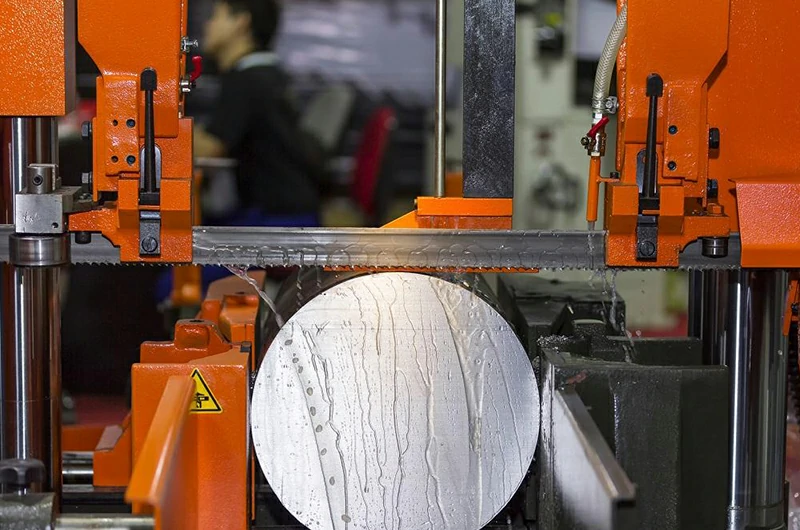
Band saw cutting has the advantages of low cost and strong versatility. It is suitable for rough machining and pre-cutting applications. With minimal material loss and easy operation, it fits initial cutting with low precision requirements.
However, its disadvantages are also obvious, including slower cutting speed, rough cut edges, and lower accuracy (tolerance about ±0.5mm). Usually, subsequent CNC or milling processing is needed to improve precision.
It is suitable for preliminary processing of titanium rods, forgings, and thick plates (over 20mm). Common uses include rough machining of titanium ingots, workpiece cutting, and initial workshop cutting.
Laser cutting
Laser cutting uses a high-energy laser beam focused on the titanium surface, causing local melting and evaporation. Combined with high-pressure assist gas, it achieves high-precision cutting, suitable for thin plates and complex shapes.
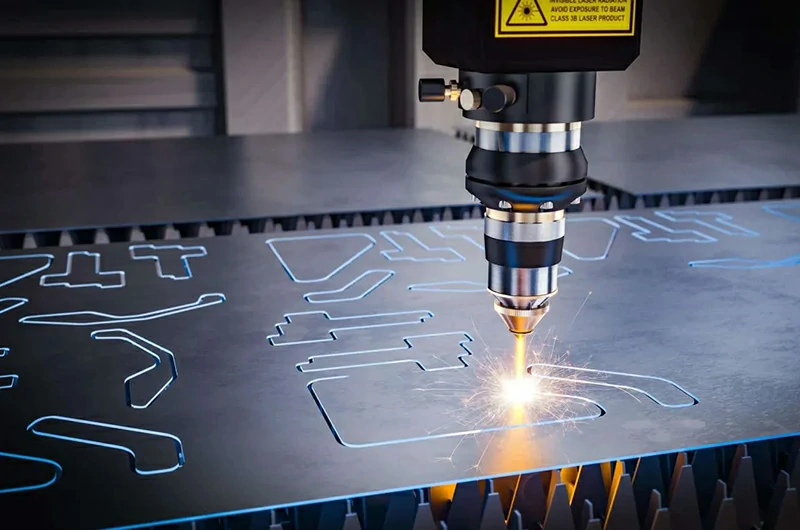
The advantages of laser cutting include high precision (typically ±0.05mm), clean cut edges, and narrow kerf (less than 0.2mm). It is ideal for high-efficiency, large-volume processing of complex structures.
It is especially suitable for thin-walled titanium products in aerospace, medical, and consumer electronics fields.
However, its heat-affected zone cannot be ignored, as it may affect edge performance before welding. It is also not suitable for cutting thick plates (over 6mm) and has a high initial equipment cost.
Laser cutting is suitable for titanium thin plates (≤6mm) and small parts with complex shapes. Common applications include medical implant shells, thin-walled brackets, and aerospace part templates requiring high precision.
Waterjet cutting
Waterjet cutting uses an ultra-high-pressure water stream mixed with garnet abrasive to perform cold cutting, producing no heat-affected zone. It is suitable for titanium alloy processing with strict surface and material property requirements.
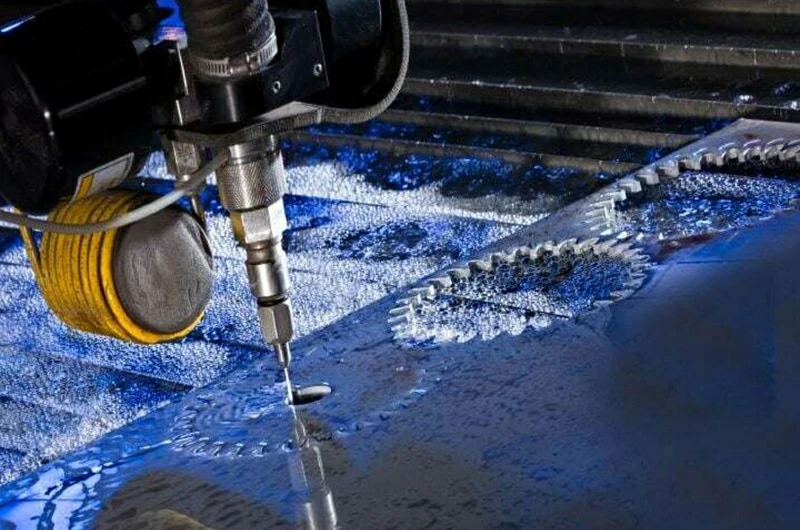
Waterjet cutting has no heat-affected zone (HAZ) and can cut titanium up to 100mm thick. It is ideal for applications where oxidation, deformation, or stress concentration are not allowed.
Cutting accuracy is stable (±0.1mm, and can reach ±0.05mm with excellent equipment) and almost does not alter material properties.
However, its cutting speed is relatively slow, operating costs are high (due to abrasive consumption), and cut edges usually require grinding or chamfering.
It is suitable for medium to thick titanium plates (≥6mm), composites, and irregular shapes. It is widely used in aerospace thick plate structures, medical device plates, and titanium plates for heat exchangers.
Plasma cutting
Plasma cutting uses a high-temperature ionized arc to instantly melt and blow away metal. It is a high-speed thermal cutting method suitable for fast cutting of industrial-grade titanium plates.
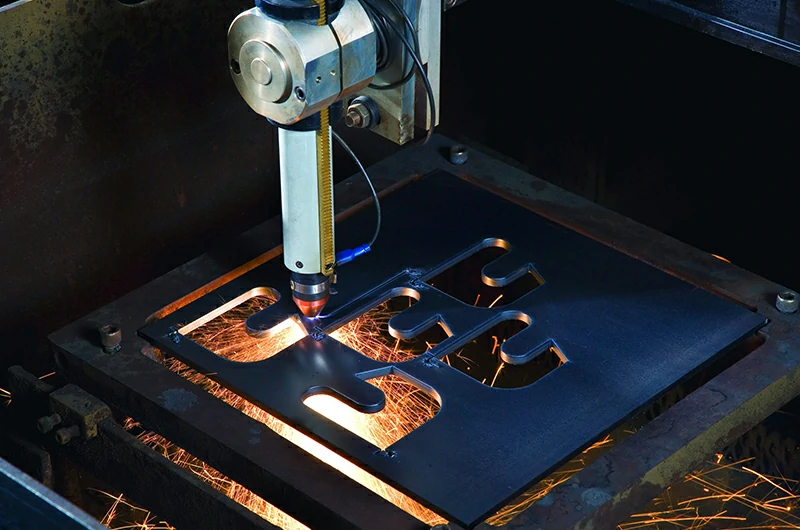
Plasma cutting is fast and moderately priced. It is one of the commonly used efficient cutting methods for industrial batch cutting, especially suitable for large titanium plates with low precision requirements.
However, its disadvantages are obvious: low cutting accuracy (±0.5mm), rough cut edges, and severe heat-affected zones. Edges often show discoloration, slag, and oxide layers, making it unsuitable for subsequent welding or precision assembly.
It is suitable for medium to thick titanium plates and structural plates (≥6mm), commonly used for cutting engineering support plates, chemical equipment shells, and industrial-grade titanium plates.
Electrical discharge wire cutting
Wire cutting uses a fine metal wire to generate electrical sparks that erode material in titanium parts, achieving extremely high-precision, non-contact machining. It is especially suitable for high hardness and complex structures.
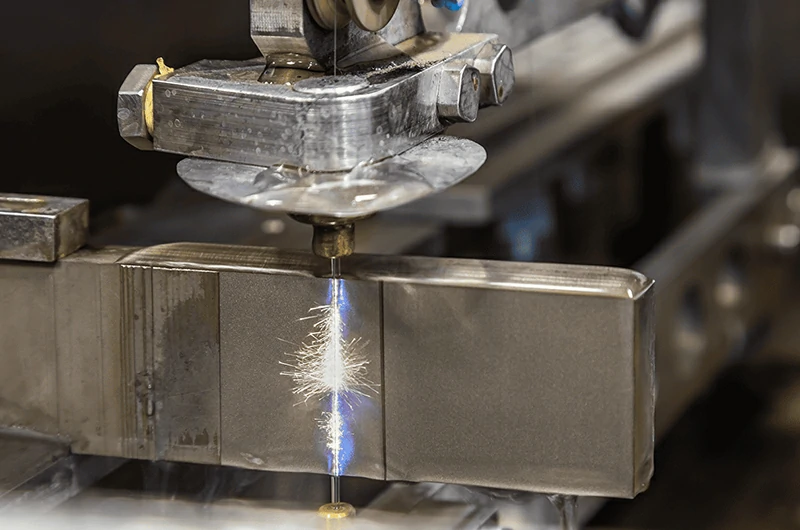
Wire cutting has very high precision (typically ±0.01mm, and can reach ±0.005mm in precision conditions). It can machine contours, fine holes, or sharp angles in titanium alloys that are difficult to achieve by mechanical methods.
The process produces no mechanical stress and deformation is unlikely. However, the machining speed is slow, and it is only suitable for conductive materials. Equipment operation and labor costs are high, making it unsuitable for large-volume ordinary cutting needs.
It is suitable for precision small titanium parts, molds, and complex contour parts. Typical applications include precision components of medical implants, aerospace high-precision slot structures, and small complex contour machining.
CNC machining
CNC is a computer numerical control cutting method capable of milling, drilling, slotting, and machining complex shapes. It is especially suitable for three-dimensional structures and multi-dimensional precision parts.
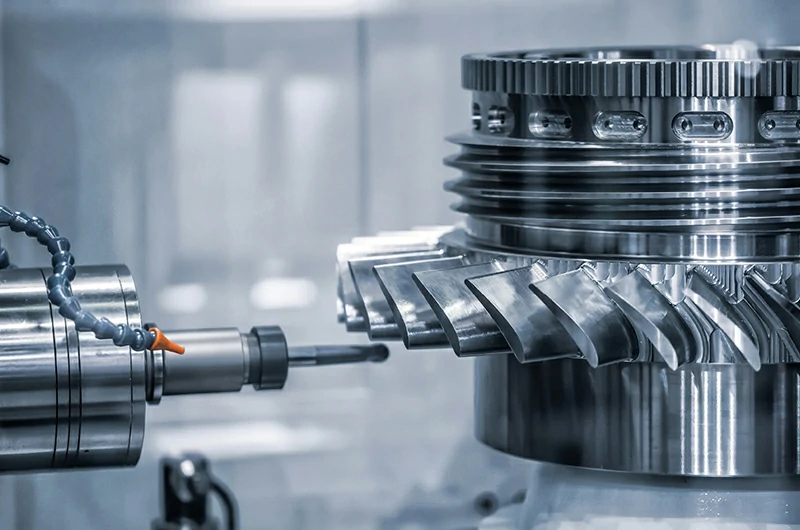
CNC machining offers excellent precision (generally ±0.01mm, with five-axis equipment reaching ±0.005mm). It is flexible in shaping, suitable for multi-dimensional surfaces, complex geometries, and structurally optimized components.
It supports one-time forming of threads, holes, chamfers, and more. However, due to titanium’s high hardness and poor thermal conductivity, tools wear out quickly. Specialized coated tools are required, and both equipment and labor costs are relatively high.
It is suitable for various custom titanium parts, precision structures, and thin-walled special-shaped parts. Typical applications include aerospace engine components, exhaust pipe elbows, and high-precision titanium brackets.
Manual cutting
Manual cutting is the most basic titanium processing method. Traditionally, handheld tools like hacksaws, scissors, angle grinders, or grinding wheels are used. It does not rely on large equipment, is easy to operate, and is widely used in small projects, maintenance sites, or early prototype production.
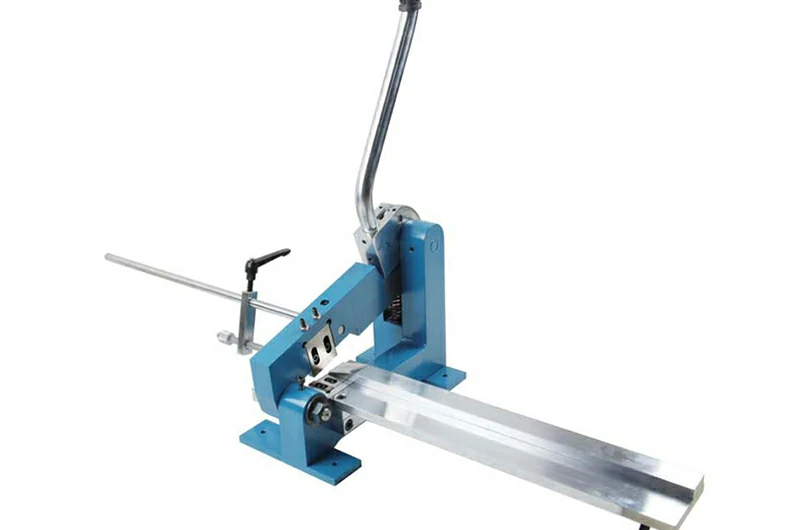
The biggest advantages of manual cutting are high flexibility, low cost, and portable equipment. It is suitable for construction sites, laboratory sample making, DIY projects, and other non-industrial scenarios.
For single or small quantities of titanium that do not require high precision, it is a quick and practical method. However, manual cutting often lacks consistency and accuracy. Typical tolerances can reach ±1mm or more. Edges are rough and may show heat discoloration. It cannot meet batch production or strict size control requirements.
It is suitable for titanium pipes, small titanium plates, and component adjustments on installation sites. Typical applications include pipeline installation on engineering sites, adjustments during construction, temporary cutting and trimming, and titanium processing in DIY projects.
Tips for successfully cutting titanium alloy
Low cutting speed can minimize heat input, reduce the possibility of material deformation, and maintain the mechanical properties of the material.
A high feed rate should be applied. A high feed rate minimizes the time the tool stays on the material, which maximizes machining efficiency and reduces tool wear.
Use plenty of cutting fluid. Adequate cutting fluid helps with lubrication and cooling, extends tool life, and minimizes overheating.
Use and replace sharp tools as needed. Timely replacement maintains consistent machining quality, while sharp tools ensure accurate cutting and eliminate excessive friction.
Avoid damage caused by contact between the tool and the workpiece. Continuous feeding prevents heat buildup, preserves tool integrity, and avoids damage to the workpiece.
How to choose the right titanium cutting method?
Choosing the right titanium cutting process requires considering the material thickness, production volume, and precision requirements. Below are recommended solutions for several typical application scenarios:
Thin plate vs thick plate
For titanium plates with a thickness of 6 millimeters or less, fiber laser cutting or CNC precision milling is recommended. Laser cutting offers clean edges, minimal deformation, and fast speed. Cutting accuracy is usually controlled within ±0.05mm. It is commonly used for thin-walled parts such as shells, brackets, and medical titanium sheets.
When the titanium thickness exceeds 6 millimeters, waterjet cutting or band saw cutting is recommended. Waterjet cutting is a cold cutting process that does not cause overheating or deformation of the material. It is suitable for heat-sensitive titanium structures or those requiring no heat-affected zones. Band saw cutting is more suitable for rough machining scenarios, such as initial blanking and cutting of ingots or large plates.
Cutting titanium rods
Titanium rods have high strength and good toughness. During processing, they generate a large amount of heat and cause significant tool wear. Common cutting methods include steel saw cutting, abrasive wheel saw, band saw cutting, and plasma cutting. Among these, band saw and abrasive wheel cutting are the most widely used, suitable for cutting titanium rods of various sizes and batches.
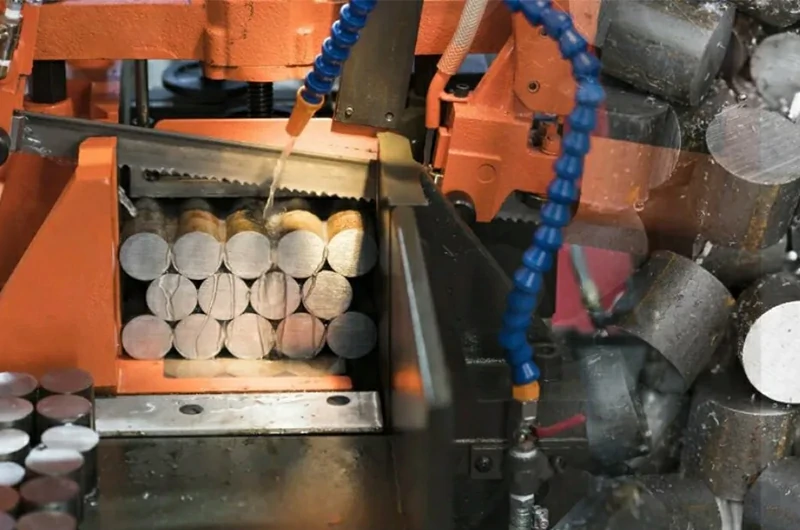
To avoid microstructural changes caused by high temperatures during cutting, it is important to minimize heat buildup from coolants or lubricants and control the cutting temperature. A low speed and light pressure cutting strategy is recommended to maintain the structural stability of the titanium rods. This ensures good dimensional straightness and flatness after cutting, facilitating subsequent precision machining or welding.
Cutting titanium tube
As a hollow cylindrical structure, titanium tubes are widely used in liquid and gas delivery systems, so the flatness, verticality and deformation-free requirements of the cut are very high. Common titanium tube cutting methods include abrasive cutting, band saw cutting and the use of special tube cutting machines. Equipment selection should be based on the diameter, wall thickness, quantity and precision requirements of the tube to match the appropriate cutting process.
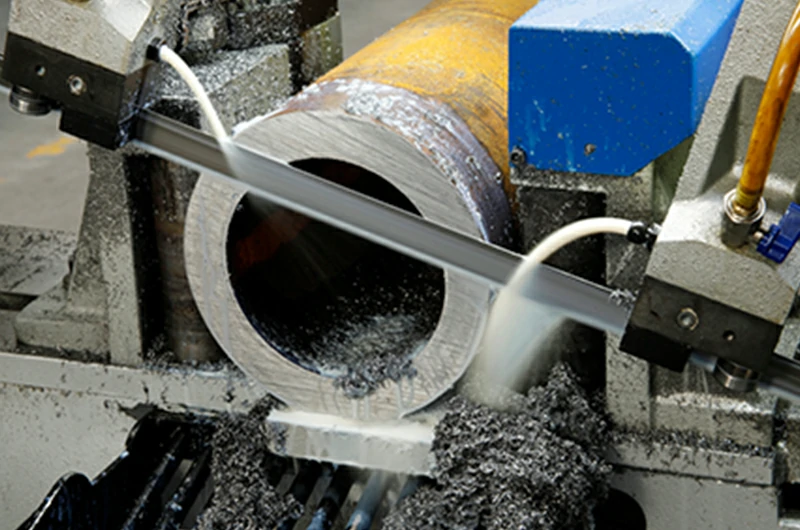
In actual operation, appropriate lubricants should be used to reduce cutting friction and prevent material deformation or blade cracking due to overheating. At the same time, a stable and uniform cutting pressure should be applied to avoid instantaneous impact. This ensures that the cutting surface is free of burrs and collapse, which facilitates the titanium tube to achieve close fit and structural sealing during subsequent welding or docking.
Small batch vs mass production
If you need to process a small quantity or are doing product prototyping, CNC machining or electrical discharge machining (EDM) is recommended. Both methods are very suitable for precise machining of complex shapes in small batches. Especially EDM, which can achieve cutting accuracy up to ±0.005mm, is commonly used in medical, mold, and aerospace fields.
For mass production, laser cutting offers better efficiency and cost advantages. It supports automated control and fast cutting speed, making it suitable for processing repetitive workpieces. If high precision is not required and only quick blanking is needed, band saw or plasma cutting can be chosen to reduce costs.
High precision vs standard precision
When a project requires extremely high dimensional accuracy (such as within ±0.01mm), EDM wire cutting or five-axis CNC machining is recommended. These processes achieve very high precision and avoid workpiece deformation caused by cutting forces or thermal effects. They are widely used in manufacturing high-value-added titanium parts, such as aerospace frame components or medical implants.
If your workpiece is only for general assembly or positioning, and dimensional accuracy requirements are around ±0.1mm, laser cutting, waterjet cutting, or band saw cutting can be chosen. Laser cutting is suitable for thin finished plates, waterjet is ideal for heat-free cutting of thick plates, and band saw is better for rough cutting during early material preparation stages.
Chalco's titanium cutting capabilities and services
Cutting titanium materials requires not only understanding the physical properties of the material itself but also relying on advanced equipment, precise process control, and rich processing experience. Chalco focuses on deep processing services for titanium and titanium alloy products, offering customized cutting solutions for various forms (titanium rods, titanium plates, titanium tubes) and different applications.
Whether you need high-precision complex structural parts or large-scale industrial materials, we provide comprehensive services including fast response, precise processing, and reliable delivery to meet the strict quality and delivery requirements of titanium processing in aerospace, medical, automotive, chemical, and other industries.
Advanced titanium cutting equipment
Chalco is equipped with multiple sets of professional titanium processing equipment, covering high-power fiber laser cutting machines, high-precision waterjet systems, CNC machining centers, EDM wire cutting, and industrial-grade band saw systems. We flexibly select the most suitable process combinations based on material types (titanium rods, plates, tubes), sizes, and cutting requirements to ensure a balanced efficiency and precision.
Customized cutting services supported
We offer personalized customization such as processing according to drawings, cutting to specified lengths, and contour cutting of special shapes. Customers can provide drawings in CAD, PDF, STEP, and other formats. Based on material properties and structural requirements, we design processes and configure parameters to ensure cutting results precisely match project needs. Whether it’s a one-time small batch order or continuous large-scale production, we have the flexibility to meet your demands.
High-precision dimensional control capability
Chalco offers dimensional control within ±0.01 mm for CNC and EDM processes. Standard laser cutting achieves accuracy within ±0.05 mm, while waterjet cutting maintains precision around ±0.1 mm. For critical applications such as medical devices, aerospace structures, or alignment components, we provide full-dimensional inspection and factory testing reports. Material certificates in accordance with EN 10204 3.1 are also available upon request.
Surface treatment and post-processing services
In addition to basic cutting services, Chalco offers secondary processing options including deburring, chamfering, grinding, sandblasting, electrolytic polishing, and anodizing to improve edge quality and surface cleanliness. We also support weld-ready packaging (ultrasonic cleaning prior to shipping), enabling customers to proceed directly with assembly or welding without additional preparation—saving both time and labor costs.




